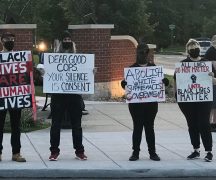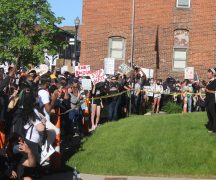By Deena Winter
The jury has spoken, and found Derek Chauvin guilty in the death of George Floyd. The former Minneapolis police officer knelt on Floyd, who was handcuffed and face down on the pavement, for more than 9 minutes at 38th Street and Chicago Avenue last May.
Chauvin was taken into custody and will be sentenced in eight weeks.
The incident was filmed by a teenager and set off a national racial reckoning after decades in which police killed Black men and were rarely punished.
Chauvin was found guilty of second-degree murder; guilty of third-degree murder; and guilty of second-degree manslaughter.
Prosecutors laid out a case over the course of 15 days that Floyd died due to a lack of oxygen, or asphyxiation, after Chauvin, a 19-year veteran on the Minneapolis police force, knelt on Floyd, 46.
In the video taken by then-17-year-old Darnella Frazier, Floyd’s face is pinned to the pavement, with Chauvin casually atop him, grinding his knee into Floyd’s neck until he went unconscious in 4 minutes and 45 seconds, had no pulse after 5 minutes and died on the street, according to a breathing expert.
Frazier testified during the trial that she’s stayed up nights “apologizing to George Floyd for not doing more and not physically interacting — not saving his life.”
Chauvin’s attorney Eric Nelson argued Floyd died from a toxic mix of fentanyl and methamphetamine and health problems ranging from heart disease to hypertension, noting the county medical examiner found no evidence of injury to Floyd’s neck or back.
After closing arguments, Nelson moved for a mistrial, saying the overwhelming media coverage of the case — including comments from elected officials — was impossible to ignore. (Jurors were not sequestered until they began deliberating Monday afternoon).
The three other officers who were on the scene — Thomas Lane, who held down Floyd’s legs; J. Alexander Kueng, who knelt on Floyd’s back and Tou Thao, who kept onlookers at bay — are scheduled to go on trial in August for aiding and abetting Chauvin.
The maximum sentence is 40 years for second-degree unintentional murder, 25 years for third-degree murder and 10 years for second-degree manslaughter. But Minnesota sentencing guidelines recommend a much shorter sentence — 12 ½ years — for murder for a person with no criminal history. Manslaughter has a presumptive sentence of four years for someone with no criminal history.





